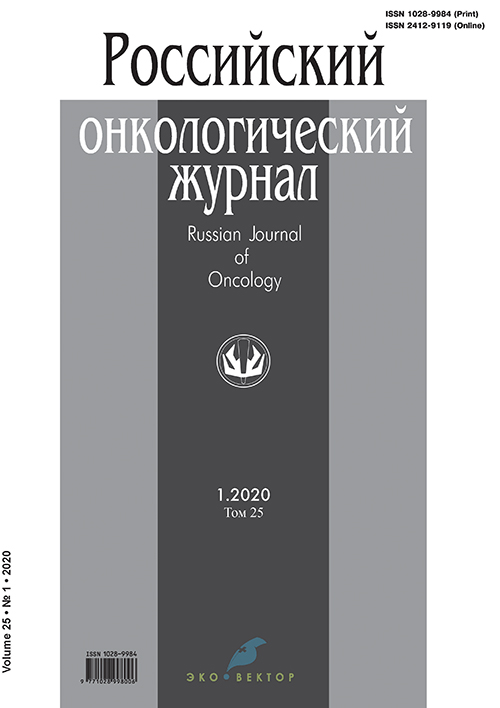A method for reducing lymphorrhea in the postoperative period after axillary lymphadenectomy for metastatic lesion in patients with skin melanoma
- Authors: Yargunin S.A.1, Shoyhet Y.N.2, Lazarev A.F.2
-
Affiliations:
- Krasnodar cancer center #1
- Altay State Medical University
- Issue: Vol 25, No 1 (2020)
- Pages: 37-41
- Section: Clinical investigations
- Submitted: 09.07.2020
- Accepted: 09.07.2020
- Published: 09.07.2020
- URL: https://rjonco.com/1028-9984/article/view/35118
- DOI: https://doi.org/10.18821/1028-9984-2020-25-1-37-41
- ID: 35118
Cite item
Abstract
Objective. Prevention of prolonged lymphorrhea, postoperative lymphocysts in patients with melanoma metastases after axillary lymph node dissection.
Material and methods. Patients with metastases of melanoma in axillary lymph nodes (n = 67) who underwent axillary lymph node dissection were studied. Patients were divided into two groups – comparisons (n = 35), which, after surgical intervention in the armpit, installed an active aspiration system according to Redon and the main (n = 32), patients of which, in addition to the draining system, installed an elastic rubber ball with water, which provided additional pressure on the skin. A significant difference (p<0.001) was established between the main and comparison groups in the number of hospital days spent by patients in the hospital. For a statistical comparison, the Mann-Whitney test was used, the distribution form was checked using the Kolmogorov-Smirnov test. The median and interquartile range (Me [Q25%–Q75%]) were determined as measures of the average tendency and spread.
Results. In the main group, patients with lymphorrhea stopped faster, drainage was removed earlier and the average hospital stay was 3 days shorter than in patients in the comparison group, and lymphocyst formation was not observed in comparison with the comparison group in which this complication was observed 11.4%.
Discussion. The duration of patients’ stay in the hospital directly depended on the date of drainage removal, the time of tissue adhesion and the end of lymphorrhea, the formation of a lymphocyst in the postoperative period, which directly depended on the application of a new technique of additional pressure on the tissues besides vacuum drainage.
Conclusion. the installation of hydraulics immediately after the operation leads to a faster gluing of the separated tissues, a reduction in lymphorrhea, and, accordingly, a shorter use of drainage, early removal and discharge of the patient from the hospital, and prevention of the formation of lymphocytes with the corresponding medical and economic effect. Priority certificate No. 2019109858 dated 04/03/2019 was received for the method used.
Full Text
About the authors
S. A. Yargunin
Krasnodar cancer center #1
Author for correspondence.
Email: sdocer@rambler.ru
Russian Federation, 350040, Krasnodar
Y. N. Shoyhet
Altay State Medical University
Email: sdocer@rambler.ru
Russian Federation, 656038, Barnaul
A. F. Lazarev
Altay State Medical University
Email: sdocer@rambler.ru
Russian Federation, 656038, Barnaul
References
- Vildy S., Nguyen J.M., Gaultier A., Knol A.C., Khammari A., Dreno B. Impact of the time interval between lymph node recurrence and lymphadenectomy on melanoma patient survival. Eur. J. Dermatol. 2017; 27 (2): 166−173. doi: 10.1684/ejd.2016.2955.
- Sladden M., Zagarella S., Popescu C., Bigby M. No survival benefit for patients with melanoma undergoing sentinel lymph node biopsy: critical appraisal of the Multicenter Selective Lymphadenectomy Trial-I final report. Br. J. Dermatol. 2015; 172 (3): 566−71. doi: 10.1111/bjd.13675.
- Koplin G., Mall J.W., Raue W., Böhm S., Hoeller U., Haase O. Quantity-guided drain management reduces seroma formation and wound infections after radical lymph node dissection: results of a comparative observational study of 374 melanoma patients. Acta Chir. Belg. 2017; 117 (4): 238−44. doi: 10.1080/00015458.2017.1296703.
- Jørgensen M.G., Toyserkani N.M., Thomsen J.B., Sørensen J.A. Surgical-site infection following lymph node excision indicates susceptibility for lymphedema: A retrospective cohort study of malignant melanoma patients. J. Plast. Reconstr. Aesthet. Surg. 2018; 71 (4): 590−6. doi: 10.1016/j.bjps.2017.11.026.
- Pergialiotis V., Kontzoglou K., Dimitroulis D., Vlachos D.E., Routsolias P., Vlachos G.D. Electrosurgical bipolar vessel sealing during axillary lymphadenectomy: a systematic review and meta-analysis. Breast Dis. 2015; 35 (1): 5−11. doi: 10.3233/BD-140383.
- Militello G., De Marco P., Falco N., Kabhuli K., Mascolino A., Licari L., Tutino R., Cocorullo G., Gulotta G. Is it really useful the Harmonic scalpel in axillary dissection for locally advanced breast cancer? A case series. G. Chir. 2016; 37 (6): 262−5.
- Gié O., Matthey-Gié M.L., Marques-Vidal P.M., Demartines N., Matter M. Impact of the Ultrasonic scalpel on the amount of drained lymph after axillary or inguinal lymphadenectomy. BMC Surg. 2017; 21, 17 (1): 27. doi: 10.1186/s12893-017-0222-1.
- Kong D., Liu Y., Li Z., Cui Q., Wang K., Wu K., Wu G. OK-432 (Sapylin) Reduces Seroma Formation After Axillary Lymphadenectomy in Breast Cancer. J. Invest. Surg. 2017; 30 (1): 1−5. doi: 10.1080/08941939.2016.1204386.
- Ten Wolde B., van den Wildenberg F.J.H., Polat F., de Wilt J.H.W., Strobbe L.J.A. Can Gentamicin-collagen Sponges Prevent Seroma Formation Following Mastectomy? Clin. Breast Cancer. 2018; 18 (5): e1023-e1026. doi: 10.1016/j.clbc.2018.02.011.
- Conversano A., Mazouni C., Thomin A., Gaudin A., Fournier M., Rimareix F., Bonastre J. Use of Low-Thrombin Fibrin Sealant Glue After Axillary Lymphadenectomy for Breast Cancer to Reduce Hospital Length and Seroma. Clin. Breast Cancer. 2017; 17 (4): 293−7. doi: 10.1016/j.clbc.2016.12.013.
Supplementary files













